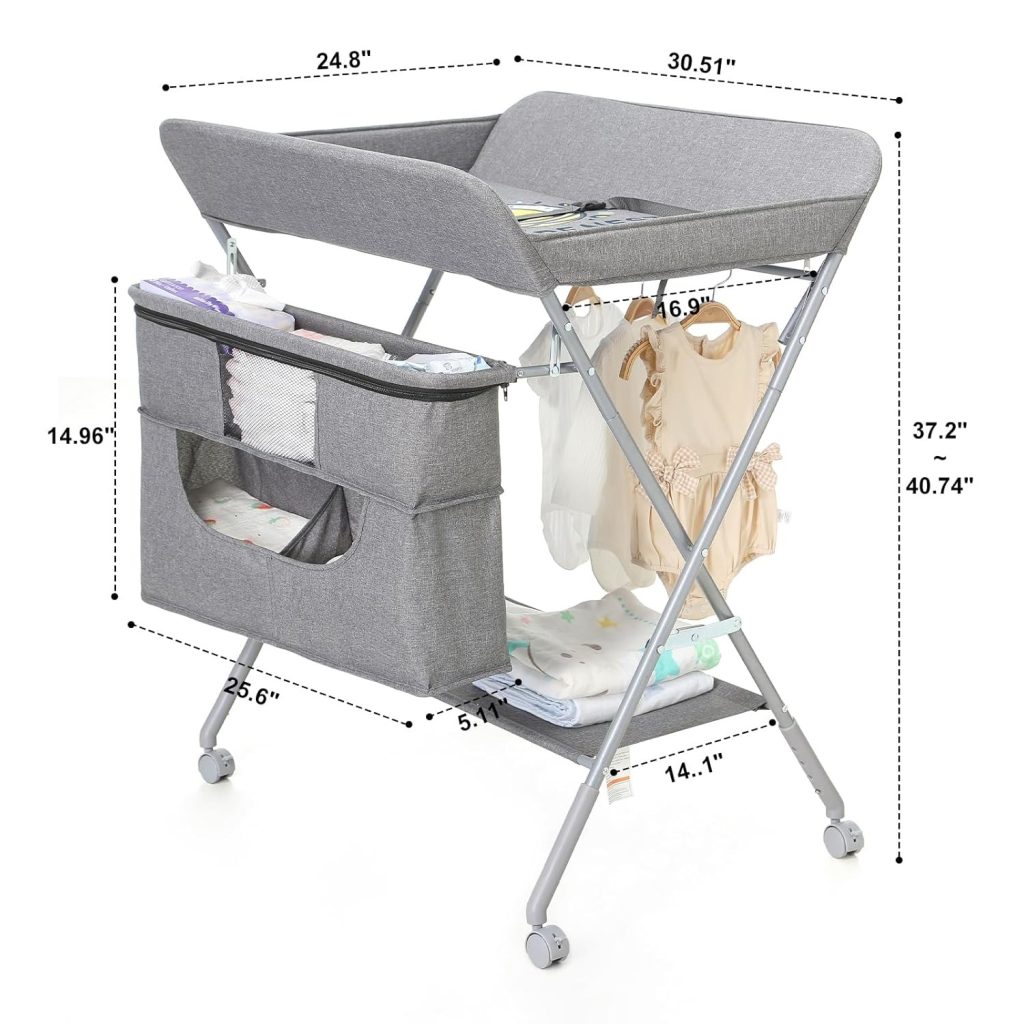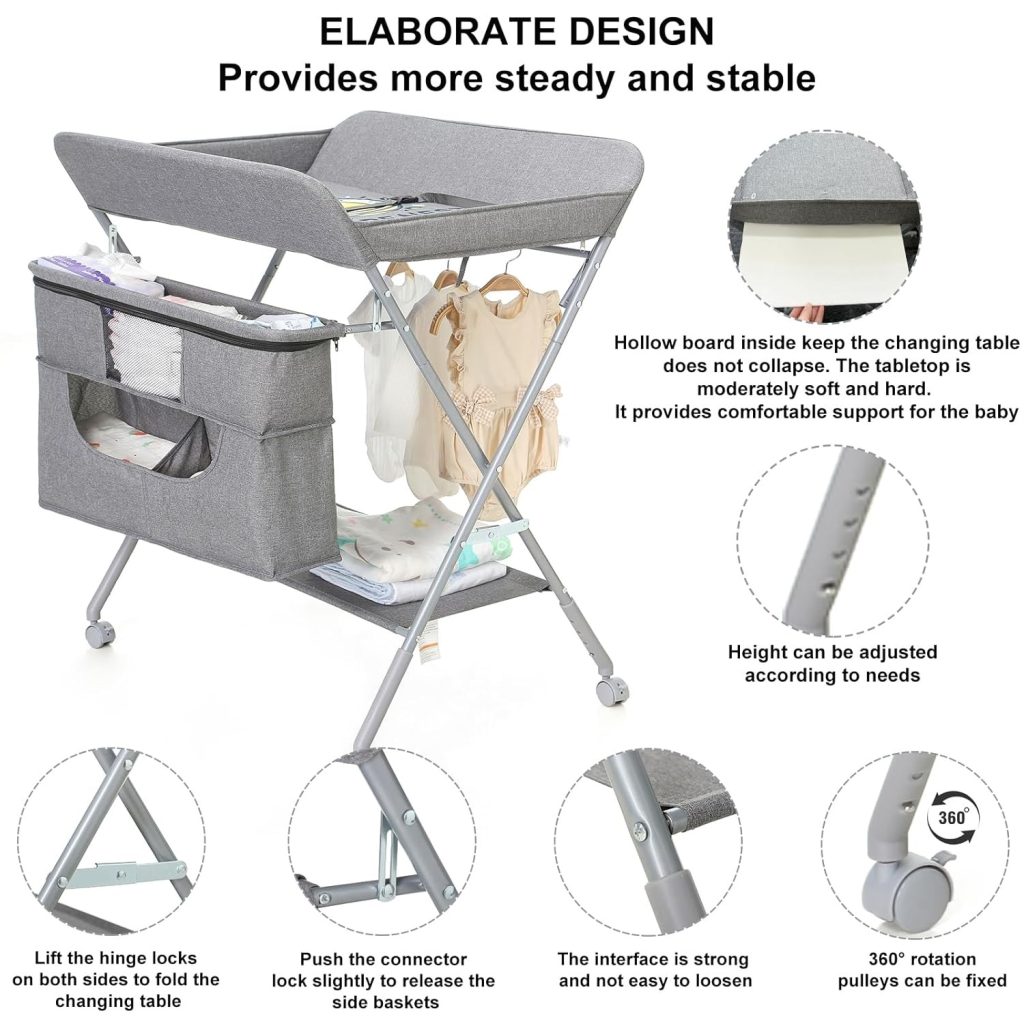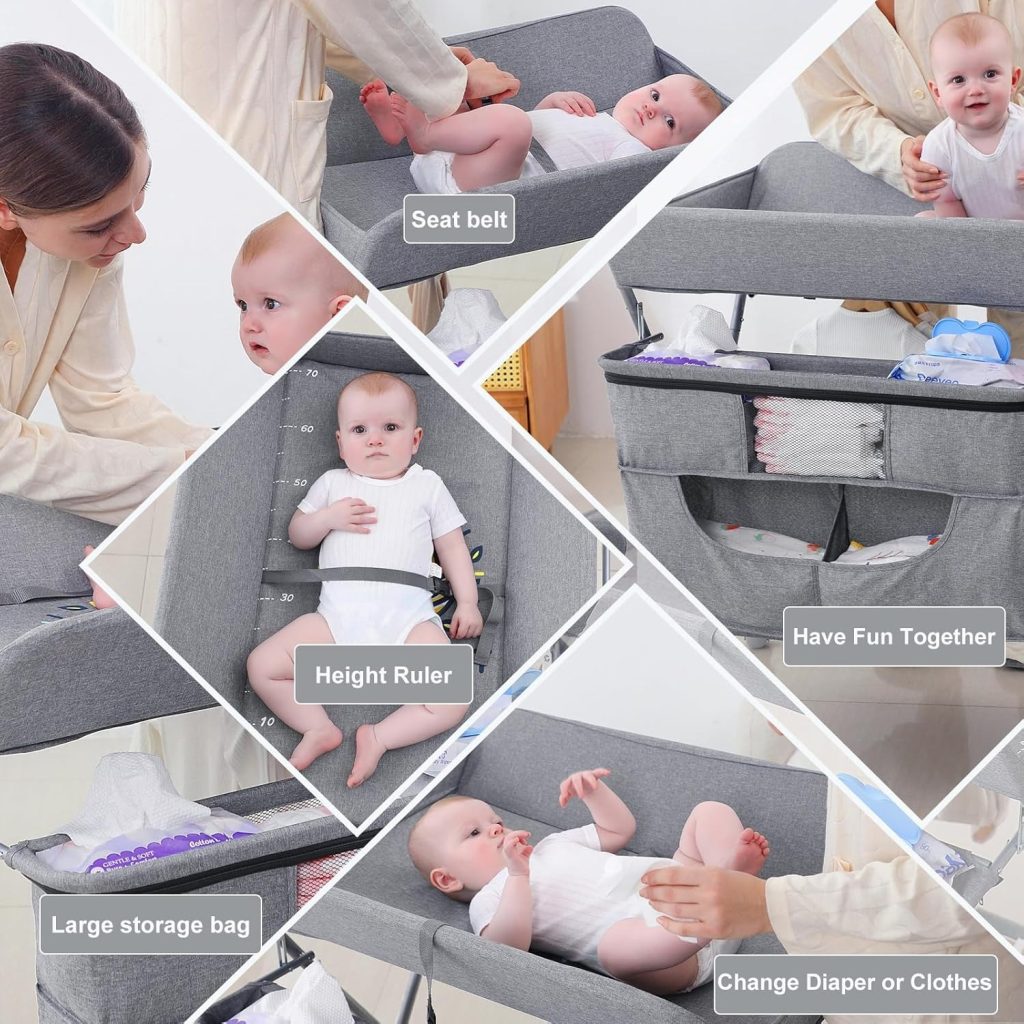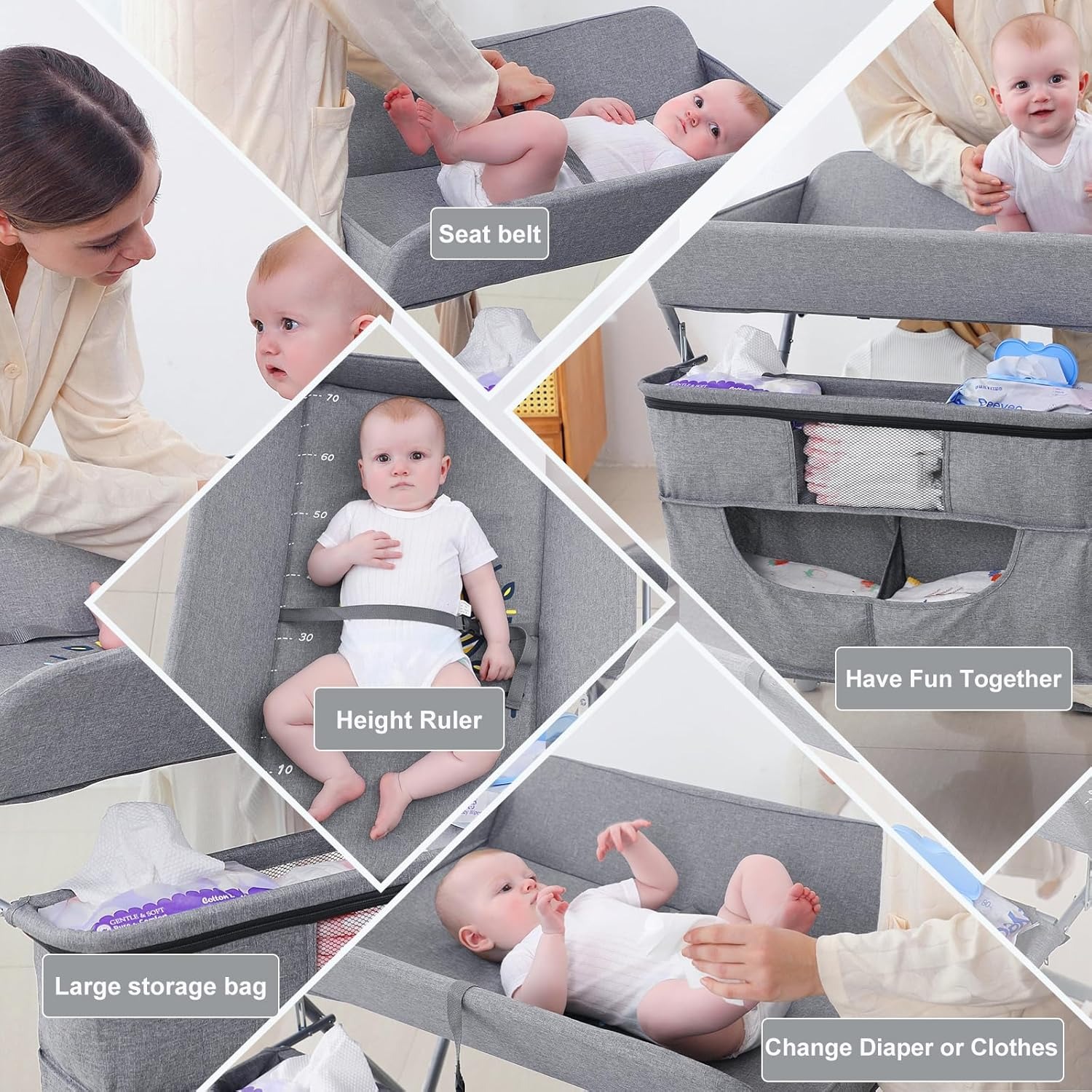What Is a Changing Nappy Table and Its Purpose?
A changing nappy table is a dedicated piece of furniture designed to streamline diaper changes while prioritizing safety and organization. Its core purpose includes:
- Baby Safety: Raised guardrails (8–10 inches high) prevent falls, while non-slip surfaces keep infants secure during wiggly moments.
- Storage Solutions: Built-in drawers or shelves store diapers, wipes, and creams within reach but out of the baby’s grasp.
- Ergonomic Design: Adjustable height reduces back strain for caregivers.
- Space Efficiency: Freestanding or wall-mounted options fit small nurseries while doubling as decor.
Ideal for home use or travel (via foldable models), it minimizes messes and offers a hygienic, baby-centric space. Unlike generic tables, it combines functionality with safety features tailored to childcare needs.

Key Features to Look For in a Changing Nappy Table
When selecting a changing nappy table, prioritize these essential features to ensure safety, convenience, and longevity:
- Adjustable Height
Telescoping legs or multi-position designs let you set the table to a comfortable height for caregivers of varying statures, reducing back strain during changes. - Non-Slip Surface
Opt for textured or padded surfaces to keep babies secure—avoid smooth finishes that allow sliding during wiggly moments. - Built-In Storage
Drawers, shelves, or integrated pockets store diapers, wipes, and creams within reach but out of the baby’s reach. Transparent containers help quickly locate items. - Safety Rails
Guardrails (8–10 inches high) prevent falls. Ensure they’re sturdy and free of gaps where fingers or toes could get trapped. - Durable & Hygienic Materials
Waterproof laminate or silicone surfaces resist stains and spills. Wooden frames should be smooth, splinter-free, and eco-friendly (e.g., birch or bamboo). - Space Efficiency
Wall-mounted models save floor space, while foldable designs suit travel or small homes. Modular options adapt to nursery layouts. - Portability (for Travel)
Lightweight, collapsible tables with carry handles or straps simplify on-the-go use. Prioritize waterproof materials for easy cleaning.
By focusing on these features, you’ll find a table that balances safety, practicality, and style for your baby’s needs.

Material and Design Considerations
Choosing the right materials and design ensures your changing nappy table is both functional and durable. Key considerations include:
- Surface Materials
Opt for waterproof laminates or silicone coatings to resist stains and spills. Avoid porous fabrics like untreated cotton, which trap moisture. - Frame Stability
Solid wood (e.g., birch, pine) or metal frames provide durability. Ensure freestanding tables have anti-tip bases to prevent tipping. - Non-Slip Elements
Rubberized backing or suction cups secure the table to floors, while padded mats keep babies in place during changes. - Eco-Friendly Options
Look for FSC-certified wood or recycled plastics. Avoid materials with harsh chemicals (e.g., PVC) for baby safety. - Space-Saving Designs
Wall-mounted tables save floor space. Foldable or collapsible models suit small homes or travel needs. - Aesthetic Flexibility
Neutral tones or themed designs (e.g., animals, pastels) match nursery decor. Adjustable shelves allow customization. - Ease of Cleaning
Removable liners or wipe-clean surfaces simplify post-change cleanup. Avoid intricate designs with hard-to-reach crevices.
These choices balance practicality and aesthetics, ensuring the table adapts to your lifestyle while prioritizing hygiene and safety.
Safety Measures to Prioritize
Ensuring a safe changing nappy table requires attention to design, installation, and usage habits. Prioritize these critical safety steps:
- Guardrails and Structural Integrity
- Install raised guardrails (8–10 inches high) to prevent falls.
- Ensure the table is sturdy and free of wobbling—use anti-tip bases for freestanding models.
- Wall-mounted tables must be bolted securely into studs, not drywall.
- Non-Slip Surface and Stability
- Choose textured or padded surfaces to keep babies in place during movement.
- Avoid slippery finishes; opt for non-slip mats or rubberized bases.
- Material Safety
- Use non-toxic, chemical-free materials (e.g., FSC-certified wood or medical-grade silicone).
- Avoid sharp edges or splinters in wooden frames.
- Hazard-Free Environment
- Keep diaper tabs, creams, or loose items out of the baby’s reach.
- Ensure the table is placed away from windows, heaters, or sharp furniture.
- Adult Supervision
- Never leave the baby unattended—even for seconds.
- Stay within arm’s reach at all times.
- Emergency Preparedness
- Keep a first-aid kit nearby for minor injuries or skin irritation.
- Store diaper rash cream and wipes within easy, but baby-proofed, access.
- Regular Inspections
- Check guardrails, screws, and surfaces monthly for wear or damage.
- Replace worn components immediately to prevent accidents.
By addressing structural, material, and behavioral safety factors, you create a secure environment for every diaper change.

Storage Solutions for a Clutter-Free Setup
Maximize organization with these changing nappy table storage ideas to keep essentials tidy and accessible:
- Built-In Drawers/Shelves
Use under-table drawers for diapers and wipes, or overhead shelves for baby books and toys. Opt for locking mechanisms to prevent baby access. - Magnetic Accessories
Attach magnetic strips to the table edge to hold wipe dispensers, cream containers, or a small trash bin. - Pocket Liners
Add removable fabric pockets to the table’s surface for storing small items like diaper rash cream or burp cloths. - Transparent Containers
Store frequently used items (e.g., diaper tabs, lotions) in clear bins so you can quickly identify contents without digging. - Modular Storage Units
Pair the table with stackable bins or a hanging organizer for extra supplies. Choose lightweight options for easy relocation. - Travel-Friendly Kits
Keep a portable pouch under the table with travel-sized wipes, diapers, and a disposable liner for on-the-go changes. - Wall-Mounted Solutions
Add hooks or shelves near the table to hang a diaper bag or store extra supplies out of the baby’s reach.
These strategies keep your setup functional and visually clean while ensuring quick access to essentials during changes.
Portable Options for On-the-Go Parents

On-the-go parents need changing nappy tables that adapt to travel and public spaces. These portable solutions ensure convenience without sacrificing safety:
- Collapsible Designs
Lightweight, foldable tables (e.g., made of nylon or silicone) compress into compact pouches. Look for ones that fit in diaper bags or car trunks. - Clip-On Attachments
Use tables with adjustable straps to secure them to strollers, luggage, or picnic tables. Some models attach to backpacks for hands-free carrying. - All-in-One Travel Kits
Opt for kits that include a portable table, a storage pouch for supplies, and a non-slip mat. Foldable options often weigh under 2 lbs. - Waterproof and Lightweight Materials
Prioritize silicone or polyester fabrics that resist stains and dry quickly. Avoid bulky padding for easier packing. - Multi-Purpose Functionality
Choose tables that double as floor mats, picnic blankets, or car seat covers. Neutral colors ensure versatility across settings. - Portable Storage Solutions
Carry disposable liners or a small travel table in a compression bag. Use a dedicated pouch to organize wipes, diapers, and creams. - Compact Wall-Mounted Options
Some tables fold vertically against walls and unfold for use, saving space in small homes or hotel rooms.
By selecting lightweight, adaptable designs, parents can maintain hygiene and safety during travel or while using public facilities.
DIY Customization Ideas
Customize your changing nappy table with these creative, budget-friendly projects to suit your baby’s needs:
- Add Storage Solutions
- Attach magnetic wipe dispensers or a small over-the-table shelf for essentials.
- Repurpose a shoe organizer as a hanging storage rack for diapers and creams.
- Decorative Upgrades
- Use non-toxic paint or contact paper to match nursery themes (e.g., stars, animals).
- Add removable decals or washi tape for easy style changes.
- Material Upgrades
- Layer a waterproof fabric cover over a wooden table to protect surfaces.
- Attach non-slip rubber mats to prevent baby movement during changes.
- Mobility Enhancements
- Install caster wheels on a freestanding table for easy relocation.
- Build a foldable tabletop with hinges for compact storage.
- Safety Add-Ons
- Reinforce guardrails with additional padding or Velcro straps.
- Use adhesive baby-safe corner guards to soften sharp edges.
- Eco-Friendly Modifications
- Repurpose old furniture (e.g., a dresser or tray) into a table with added guardrails.
- Line the table with recycled materials like old towels or shower curtains.
- Smart Technology Integration
- Attach a baby monitor clip to the table for remote supervision.
- Use a motion sensor light to illuminate the area during nighttime changes.
These ideas balance creativity and functionality, offering personalized solutions without breaking the bank.

FAQs About Changing Nappy Tables
Q1: Can a changing nappy table replace a regular table?
No—dedicated tables offer safety features (e.g., guardrails) and storage, unlike generic tables.
Q2: How do I ensure safety during use?
Install guardrails (8–10 inches high), avoid leaving the baby unattended, and secure wall-mounted tables into studs.
Q3: Are tables machine-washable?
Some surfaces are removable and washable—check labels. Clean spills immediately with disinfectant wipes.
Q4: Are portable options travel-friendly?
Yes—look for lightweight, collapsible models with non-slip surfaces for secure use anywhere.
Q5: What size should I choose?
Measure your space precisely. Leave 1–2 inches of extra width/length for comfort and safety.
Q6: Are eco-friendly materials available?
Yes—opt for FSC-certified wood, recycled plastics, or silicone. Avoid PVC or chemically treated options.
Q7: Do I need built-in storage?
Recommended—drawers or shelves keep essentials organized while keeping items out of the baby’s reach.
Q8: How often should I clean the table?
Wipe surfaces after every use. Deep-clean weekly with mild detergent and water.
Q9: Is it suitable for toddlers?
Yes, but check weight limits (most support up to 30 lbs). Transition to a step stool as they grow.
Q10: How long do tables typically last?
With proper care, 3–5 years. Replace if surfaces crack, rails loosen, or leaks occur.
